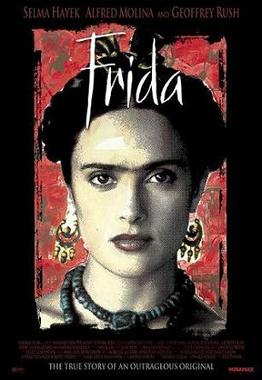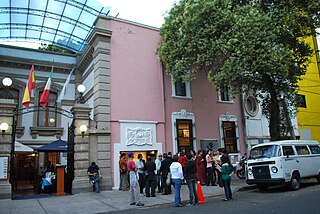Related Research Articles

Diego María de la Concepción Juan Nepomuceno Estanislao de la Rivera y Barrientos Acosta y Rodríguez, known as Diego Rivera, was a prominent Mexican painter. His large frescoes helped establish the mural movement in Mexican and international art.

Magdalena Carmen Frida Kahlo y Calderón was a Mexican painter known for her many portraits, self-portraits, and works inspired by the nature and artifacts of Mexico. Inspired by the country's popular culture, she employed a naïve folk art style to explore questions of identity, postcolonialism, gender, class, and race in Mexican society. Her paintings often had strong autobiographical elements and mixed realism with fantasy. In addition to belonging to the post-revolutionary Mexicayotl movement, which sought to define a Mexican identity, Kahlo has been described as a surrealist or magical realist. She is also known for painting about her experience of chronic pain.

Guerrilla Girls is an anonymous group of feminist, female artists devoted to fighting sexism and racism within the art world. The group formed in New York City in 1985, born out of a picket against the Museum of Modern Art the previous year. The core of the group's work is bringing gender and racial inequality into focus within the greater arts community and society at large. The Guerrilla Girls employ culture jamming in the form of posters, books, billboards, lectures, interviews, public appearances and internet interventions to expose disparities, discrimination, and corruption. They also often use humor in their work to make their serious messages engaging. The Guerrilla Girls are known for their "guerrilla" tactics, hence their name, such as hanging up posters or staging surprise exhibitions. To remain anonymous, members don gorilla masks. To permit individual identities in interviews, they use pseudonyms that refer to deceased female artists such as Frida Kahlo, Käthe Kollwitz, and Alice Neel, as well as writers and activists, such as Gertrude Stein and Harriet Tubman. According to GG1, identities are concealed because issues matter more than individual identities, "Mainly, we wanted the focus to be on the issues, not on our personalities or our own work."

Frida is a 2002 American biographical drama film directed by Julie Taymor which depicts the professional and private life of the surrealist Mexican artist Frida Kahlo.

Tina Modotti was an Italian American photographer, model, actor, and revolutionary political activist for the Comintern. She left her native Italy in 1913 and emigrated to the United States, where she settled in San Francisco with her father and sister. In San Francisco, Modotti worked as a seamstress, model, and theater performer and, later, moved to Los Angeles where she worked in film. She later became a photographer and essayist. In 1922 she moved to Mexico, where she became an active member of the Mexican Communist Party.

The National Museum of Women in the Arts (NMWA), located in Washington, D.C., is "the first museum in the world solely dedicated" to championing women through the arts. NMWA was incorporated in 1981 by Wallace and Wilhelmina Holladay. Since opening in 1987, the museum has acquired a collection of more than 6,000 works by more than 1,000 artists, ranging from the 16th century to today. The collection includes works by Mary Cassatt, Alma Woodsey Thomas, Élisabeth Louise Vigée-LeBrun, and Amy Sherald. NMWA also holds the only painting by Frida Kahlo in Washington, D.C., Self-Portrait Dedicated to Leon Trotsky.

Lola Álvarez Bravo was the first Mexican female photographer and a key figure in the post-revolution Mexican renaissance. Known for her high level of skill in composition, her works were seen by her peers as fine art. She was recognized in 1964 with the Premio José Clemente Orozco, by the State of Jalisco, for her contributions to photography and her efforts to preserve the culture of Mexico. Her works are included in the permanent collections of international museums, including the Museum of Modern Art in New York City.

The Museo de Arte Moderno (MAM) is a museum dedicated to modern Mexican art located in Chapultepec Park in Mexico City.
María Izquierdo was a Mexican painter. She is known for being the first Mexican woman to have her artwork exhibited in the United States. She committed both her life and her career to painting art that displayed her Mexican roots and held her own among famous Mexican male artists: Diego Rivera, José Clemente Orozco, and David Alfaro Siqueiros.

Favianna Rodriguez is an American artist and activist known for her work in political posters and public art.

Alice Phillipot (Alice Rahon) (8 June 1904 – September 1987) was a French-born Mexican poet and artist whose work contributed to the beginning of abstract expression in Mexico. She began as a surrealist poet in Europe but began painting in Mexico. She was a prolific artist from the late 1940s to the 1960s, exhibiting frequently in Mexico and the United States, with a wide circle of friends in these two countries. Her work remained tied to surrealism but was also innovative, including abstract elements and the use of techniques such as sgraffito and the use of sand for texture. She became isolated in her later life due to health issues.
Paula Santiago is a Gallega mixed media digital artist whose works have been displayed at the Apóstol Santiago and several galleries in Galicia and North America. Most of her work stands out by being made with her own blood and hair.
Amalia Mesa-Bains, is a Chicana curator, author, visual artist, and educator. She is best known for her large-scale installations that reference home altars and ofrendas. Her work engages in a conceptual exploration of Mexican American women's spiritual practices that addresses colonial and imperial histories of display, the recovery of cultural memory, and their roles in identity formation.

Salón de la Plástica Mexicana is an institution dedicated to the promotion of Mexican contemporary art. It was established in 1949 to expand the Mexican art market. Its first location was in historic center of the city but today it mostly operates out of a building in Colonia Roma. The institution is run by a membership of almost four hundred recognized artists and holds multiple exhibitions each year. Although it operates autonomously, it is part of the Instituto Nacional de Bellas Artes y Literatura.
Nahum B. Zenil is a Mexican artist who often uses his own self-portrait as the principal model for a cultural critical interpretation of Mexico, especially concerning homosexuality and mestization. Zenil was born in 1947 in the state of Veracruz. In 1959, he enrolled at the Escuela Nacional de Maestros in Mexico City, from which he graduated in 1964. It was during this period in which Zenil became interested in painting. He later entered the Escuela Nacional de Pintura y Escultura in Mexico City in 1968. He is also one of the founding members of the Semana Cultural Gay, which occurs yearly at the Museo Universitario del Chopo. His art is often compared to that of Frida Kahlo, in which the self becomes the principal object of their paintings letting the viewer discover the artists as individuals as well as the broader social and cultural contexts in which they lived through the medium of self-portraiture.
Myra Bairstow is an American writer and independent art scholar and curator. She was the co-author and director of the Manierre Dawson Catalogue Raisonné in collaboration with the Hollis Taggart Galleries published in 2011. Bairstow's curatorial exhibitions with the Taggart Galleries include "Manierre Dawson: American Pioneer of Abstract Art", "Manierre Dawson: New Revelations" (Chicago) and "Manierre Dawson" A Catalogue Raisonné.
Dorothy Hood was an American painter in the Modernist tradition. Her work is held in private collections and at several museums, most notably the Museum of Modern Art and Museum of Fine Arts, Houston. Her preferred mediums were oil paint and ink.
Deborah Cullen is an American art curator and museum director, with a specialization in Latin American and Caribbean art.
Teresa del Conde Pontones was a Mexican art critic and art historian.
José Luis Romo Martín was a Mexican painter, sculptor and graphic artist of Otomi -Hñäñhü- heritage.
References
- 1 2 Cheek, Samantha (September 12, 1996). "Archer M. Huntington Art Gallery Selects Latin American and Latino(a) Research Fellows for Rockefeller Foundation Program". The University of Texas at Austin. Retrieved 21 March 2015.
- ↑ "Documents of the 20th Century Latin American and Latino Art". International Center for the Arts of the Americas. International Center for the Arts of the Americas. Retrieved 21 March 2015.
- 1 2 3 4 5 "Carla Stellweg papers, 1960-2009 M1752". Online Archive of California. Stanford University. Retrieved 21 March 2015.
- 1 2 Cuy, Sofía Hernández Chong (April 1, 2010). "Visual Arts Facsimile". Sideshows. Sofía Hernández Chong Cuy. Retrieved 21 March 2015.
- ↑ Giunta, Andrea (October 2013). "Feminist Disruptions in Mexican Art, 1975 - 1987". Artelogie VI (5). Archived from the original on 26 October 2014. Retrieved 24 February 2015.
- ↑ Aceves, Gabriela (October 2013). "¿Cosas de Mujeres ?: Feminist Networks of Collaboration in 1970s Mexico". Artelogie (5). Retrieved 21 March 2015.
- ↑ "Stellweg Seguy Gallery Inc". Business Lookup. Business Lookup. Archived from the original on 29 September 2015. Retrieved 21 March 2015.
- ↑ Wolff, Elaine (25 June 2008). "CAM Wiki History". San Antonio Current. Retrieved 21 March 2015.
- ↑ "Our Faculty: Carla Stellweg - Curator, art historian, editor; interim director, White Box". School of Visual Arts. School of Visual Arts. Retrieved 21 March 2015.